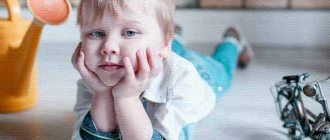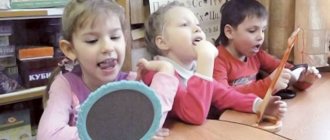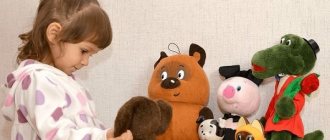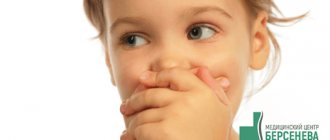Children aged 3 to 4 years develop quite actively, not only physically, but also emotionally. Three-year-olds can do a lot of things, especially when compared with 1- and 2-year-olds, but it is still difficult for them to concentrate on any one activity. So that the baby does not get bored and does not stop in his development, you need to constantly change exercises from mental to physical. In addition, during this interval, many children experience the so-called crisis of three years. That is why parents need to know how to develop a child at 3 years old correctly.
Developmental exercises for children of this age should be aimed at developing:
- speech and vocabulary;
- logic and mathematical abilities;
- artistic and creative skills;
- fine motor skills.
Physical development: height, weight, motor skills
The physical development parameters of a 3-year-old child vary within the following framework:
- weight – from 12.5 to 15 kg;
- height – from 91 to 100 cm.
First of all, remember that neither at 3 years old nor at any other age does a child owe anything to anyone! All children are completely different, and the development of the baby is strictly individual. But there are certain guidelines that help parents in raising and developing a child.
A 3 year old child must have:
- everyday skills - eating independently with a fork and spoon, dressing, undressing, washing hands before eating, washing, brushing teeth, knowing where his clothes are;
- motor skills - climbing and dismounting stairs, sliding down a slide, being able to kick a ball, jumping, running, riding a scooter, balance bike or tricycle.
The development of 3-year-old children should be comprehensive, since during this period children are most susceptible to everything new and unknown. When working with children, you cannot focus on anything specific. Classes should be conducted in the form of a game so that the little fidget does not get bored. It is through playing that children learn about the norms of behavior in society.
Fresh air, daily long walks in the park and forest area, a sufficient amount of ultraviolet rays contribute to the methodical development of your child. While walking together, play outdoor games, which are very important for strengthening the muscles and increasing the growth of the child’s bones. During games, do not forget to monitor your child's posture. Movement in the fresh air and water procedures, which children love so much, increase metabolism in the body and develop the baby’s respiratory and cardiovascular systems.
It is important to remember: at the age of 3 years, a child should not be obedient, diligent, neat, patient, be able to write numbers and letters, or overcome difficulties.
Don't overestimate your child and don't put things too difficult on him.
Photo source: shutterstock.com
How to recognize developmental disabilities
You should pay special attention to your child if he:
- does not seek to communicate with other children. Perhaps he is not accepted into the game because the baby’s speech is incomprehensible to others;
- is in too much of a hurry and swallows some of the words;
- cannot answer simple questions;
- does not recognize and cannot distinguish objects.
If the above symptoms are present, the child should be shown to a specialist. Do not worry ahead of time, because it is likely that these deviations may disappear after the first exercises.
Remember that every child is individual. And not everyone meets certain standards.
Mental development: what happens at this age? Standard options
First, let's describe the skills that a three-year-old usually possesses:
- Speech skills. By the age of 3, the child should be able to speak. But if this hasn’t happened to your baby yet, don’t panic. Just pay attention to this and consult your pediatrician.
- A child of 3 years old understands speech addressed to him. Three-year-olds, having 500-1500 words in their active vocabulary, construct sentences and even short stories, and use metaphors and images in conversation.
- He knows everything about himself: what is his name, how old is he, where does he live, the names of his parents.
- Based on pictures or descriptions, he can guess an object, find similarities and differences.
- Knows how to build cause-and-effect relationships and relies on them in his behavior. Some kids not only understand this, but also know how to explain it in words.
- The ability to make acquaintances and friendships is strictly individual. It all depends on the character of the baby. Often girls at this age already play games together, while boys show interest in playing games together later.
- There is a desire to help parents in their adult affairs. The main thing here is not to hinder your zeal and do household chores together. Believe me, with the right approach you will only enjoy the joint activities.
- By this age, the baby plays role-playing games. Now, using the example of a teddy bear or doll, you can easily explain to him why it is so important to go to bed on time and brush your teeth well. He easily integrates into your game, thereby becoming an excellent partner in joint games.
Age features of development of children 3–4 years old
VARENOVA MARINA
Age features of development of children 3–4 years old
Age features of development of children 3-4 years old
Physical development
A 3-year-old child masters basic vital movements (walking, running, climbing, handling objects)
. Interest arises in determining whether movements correspond to a pattern. Children test their strength in more complex activities, but at the same time they are characterized by the inability to measure their strength with their capabilities.
The motor skills of performing movements are characterized by a more or less accurate reproduction of the structure of the movement, its phases, direction, etc. By the age of 4, a child can walk along a gymnastic bench without stopping, arms to the sides; hit the ball on the floor and catch it with both hands (3 times in a row)
;
transfer small objects one at a time (buttons, peas, etc. - 20 pieces in total)
from the table surface into a small box
(with your right hand)
.
begins to develop when performing physical exercises, while children are guided to a large extent by the teacher’s assessment.
A 3-4 year old child has basic hygienic self-care skills (washes hands independently and correctly with soap after walking, playing, or going to the toilet; carefully uses the toilet: with toilet paper, does not forget to flush the water from the tank; when eating, uses a spoon or napkin; knows how to use a handkerchief; can independently eliminate the mess in clothes, hairstyle, using a mirror, comb).
Social and communicative development
By the age of three, a child reaches a certain level of social competence: he shows interest in another person, has confidence in him, strives to communicate and interact with adults and peers. The child develops personal sympathies, which manifest themselves in the desire to share a toy, provide help, and comfort. The child experiences an increased need for emotional contact with adults, clearly expresses his feelings - joy, grief, fear, surprise, pleasure, etc. To establish contacts with other people, he uses verbal and non-verbal (looks, facial expressions, gestures, expressive poses and movements)
methods communication _ Aware of his gender identity ( “I am a boy”
,
“I am a girl”
).
The fundamental characteristic of a three-year-old child is independence ( “I myself”
,
“I can”
).
He actively declares his desire to be like adults (eat, dress himself, get involved in real affairs (wash dishes, do laundry, do shopping, etc.)
." Interaction and communication
of children of the fourth year of life are superficial, situational, instability, short duration, most often initiated by an adult.
For children of 3 years of age, playing nearby is typical. In the game, children perform individual play actions that are conditional in nature. The role is actually carried out, but is not named. The plot of the game is a chain of 2 actions; an imaginary situation is held by an adult ". By the age of 4, children can unite in groups of 2-3 to play the simplest role-playing games. Game actions are interconnected, have a clear role-playing character. The role is called, as the game progresses, children can change the role. The game chain consists of 3-4 interconnected actions Children independently hold an imaginary situation.
Cognitive and speech development
A child’s communication at this age is situational , initiated by an adult, unstable, and short-term. Aware of his gender identity. A new form of communication with adults arises - communication on cognitive topics, which is first included in joint cognitive activity with an adult.
The uniqueness of the speech development of children at this age is that during this period the child has increased sensitivity to language, its sound and semantic side. In early preschool age, a transition occurs from the exclusive dominance of situational (understandable only in a specific situation)
speech to the use of both situational and contextual
(free from a visual situation)
speech. Mastery of the native language is characterized by the use of basic grammatical categories (coordination, their use in number, tense, etc., although individual errors are allowed) and a vocabulary of colloquial speech. Possible defects in sound pronunciation.
As develops the ways and means of orienting a child in the environment expand and qualitatively change The child actively uses certain household objects, toys, substitute objects and verbal designations of objects for their intended purpose in everyday life, play, and communication. Qualitatively new properties of sensory processes are formed: sensation and perception. In practical activities, the child takes into account the properties of objects and their purpose: knows the name 3 -4 colors and 2-3 shapes; can choose from 3 items of different sizes “the largest”
.
When looking at new objects (plants, stones, etc.),
the child does not limit himself to simple visual familiarization, but moves on to tactile, auditory and olfactory perception.
Memory images begin to play an important role. The child's memory and attention are involuntary, passive. At the request of an adult, a child can remember at least 2-3 words and 5-6 names of objects. By the age of 4, he is able to remember significant passages from his favorite works.
Looking at objects, the child identifies one, the most striking feature of the object, and, focusing on it, evaluates the object as a whole. He is interested in the results of actions, but the process of achievement itself is not yet able to trace. Constructive activity in 3-4 years is limited to the construction of simple buildings according to the model (of 2-3 parts)
and by design. The child can engage in activities that are exciting for him without interruption for 5 minutes.
Artistic and aesthetic development
The child enjoys getting acquainted with elementary means of expressiveness (color, sound, shape, movements, gestures, and shows interest in works of folk and classical art, in literature (poems, songs, nursery rhymes, in performing and listening to musical works.
A child’s visual activity depends on his ideas about the subject. At 3-4 years old they are just beginning to form. Graphic images are poor, objective, and schematic. For some preschoolers, the images lack details; for others, the drawings may be more detailed. The idea changes as the image progresses. Children can already use color. Modeling is of great importance for . A child can sculpt simple objects under the guidance of an adult. At 3-4 years old, due to insufficient development of the small muscles of the hand , children do not work with scissors; they applique from ready-made geometric shapes. The child is able to lay out and paste elements of a decorative pattern and an object schematic image from 2-4 main parts.
In musical-rhythmic activity, a 3-4 year old child feels the desire to listen to music and make natural movements to the sound of music. By the age of 4, he masters basic singing skills of simple musical works. The child transforms well into the image of a bunny, bear, fox, cockerel, etc. in movements, especially to a dance melody. Acquires basic skills of playing along with children's percussion musical instruments (drum, metallophone)
.
The foundations are laid for the development of musical, rhythmic and artistic abilities .
SOCIAL-EMOTIONAL DEVELOPMENT :
Loves to give toys and take them from others. Loves to communicate with children and adults. Cooperative playing skills are developed Likes to help adults.
GENERAL MOTOR SKILLS, HAND MOTOR SKILLS:
Throws the ball over his head. Grabs a rolling ball and walks down the stairs, using one leg or the other alternately. Jumps on one leg. Stands on one leg for 10 minutes. Maintains balance when swinging on a swing. Holds a pencil with his fingers. Collects and builds from 9 cubes.
VISUAL-MOTOR COORDINATION:
He traces contours, copies a cross, reproduces shapes, including the shape of a hexagon.
PERCEPTION AND OBJECT-GAME ACTIVITY:
Disassembles and folds a six-piece matryoshka doll. Lowers the figures into the slots through targeted trials. Constructs from cubes by imitation. Folds a cut picture from 2-3 parts by trial.
SPEECH DEVELOPMENT :
Intensive speech development . Determines color, shape, texture, taste, using definition words. Knows the purpose of basic items. Understands degrees of comparisons (closest, largest)
.
Determines the gender of people by their role in the family (he is dad, she is mom)
. Understands time and uses past and present tense. Counts to five.
SPEECH COMPREHENSION:
Understands the names of colors: “Give me a red ball.” Listens to long tales and stories. Follows a two-part instruction (“Give me a red cube and a blue ball”)
.
Crisis 3 years
It is at the age of 3 that a child’s behavior changes dramatically. Many parents are perplexed: why did their sweet baby turn into a naughty capricious child?
In fact, there is such a thing as adolescence. Actually, at 3 years old the first age crisis occurs. At 3 years old, a child separates himself from the world around him. He is no longer part of the world, now the baby is learning to say the word “I”.
The child claims independence and begins to build his relationships with the environment.
At 3 years old, he exhibits more and more negative behaviors. How? He contradicts his mother: “I don’t want to,” “I won’t.” Becomes disobedient and capricious. And the familiar “I myself” can be heard in any conversation with your baby.
How should parents behave in order to smooth out the consequences of the 3-year crisis?
Show maximum tact and patience with your child. Give as much freedom and independence as possible.
Even if you are very late, wait for him to tie his shoelaces and fasten his button. Believe me: by waiting a little, you will save yourself and your child’s nerves. And the relationship with your child will reach another level and become even stronger.
If you limit a child’s actions during such an important period of growing up, you will end up with a dependent, dependent person.
Emotional and social development
A child at this age is able to make friends on his own and solve his first childhood problems: take turns playing, arguing and making peace. Emotionally he becomes more independent
. The following social skills are typical for this age:
- imitation of parents, friends;
- understanding of “mine” and “her/his”;
- the ability to express happiness, anger, sadness and other emotions;
- expression of affection for acquaintances and friends.
The imagination develops, which can cause unrealistic fears, for example, belief in a monster under the bed.
For improvement in this direction, the VIKILAND children's club offers the following lesson programs:
- 4 steps with mom;
- Baby Time;
- Painting lessons for children.
Dance group programs can be used as auxiliary programs: “from classical to jazz,” rhythmics and choreography, pop dancing and classical ballet classes.
Adaptation in kindergarten
Most often in our country, it is at the age of 3 that a child receives a ticket to kindergarten. Regardless of the character and temperament of the child, adaptation occurs for everyone.
Here are some tips to help you and your child get through this period as smoothly as possible:
- Take some time to get used to it. The best option is 3-4 weeks part-time. Even if the teachers advise you to leave the child and go away, do not agree. Find an opportunity to be with him, do not leave him alone during such a difficult period. If your baby plays with children and doesn’t need you, then just watch him from the side.
- Try to create a comfortable environment in the garden and at home. Allow you to take your baby's favorite toy into the group if he asks for it.
- It is important that at home the child is given the opportunity to switch. During adaptation to kindergarten, you cannot demand that he be an angel at home. The baby gets very tired psychologically. Let him just lie at home if he wants. Or, on the contrary, he makes noise, screams and runs. He needs to learn to compensate and balance the mental load.
- Do not burden your baby with additional sections and circles. First, let him get used to one thing.
- The child needs your support. Outside the garden, give it all of yourself: chat, play, read, walk. Put down your phone and computer and spend time together.
- Talk to your child. Ask questions, find out the names of your child’s teachers and friends. Take an interest in your child's kindergarten life.
- If just a few months ago a baby was born in the family, do not send your older child to kindergarten. Having a younger brother or sister is already stressful, don't add additional stress.
- Make friends with teachers. Ask them about how your baby behaves in kindergarten and how his peers treat him.
Photo source: shutterstock.com
Find out our good sides
Get to know our good sides and become our friends!
VIKILAND – CLUB FOR THE WHOLE FAMILY
The Vikiland family club is a unique place where every family member can find an interesting activity for themselves, regardless of age.
We have collected all the in-demand comprehensive developmental activities under one roof, so that it is convenient for parents to bring their children to one place and not have to travel across the city from one club to another.
Come with the whole family and bring your friends!
CONVENIENT SCHEDULE OF CLASSES
Vikiland has a range of interesting activities for every age. The schedule on our website allows you to choose a convenient time to visit. The club is open from 10 am to 10 pm. Classes are structured in such a way that children can be left with us in the morning. They move from activity to activity throughout the day within their age group under the supervision of our nanny.
Cognitive activity
Cognitive activity is an active activity that is aimed at mastering new skills and obtaining new knowledge.
By 3-4 years old, the child:
- Knows the seasons and by what signs they can be identified.
- Knows the daily routine and is able to reproduce it.
- Focuses on daily time periods.
- Knows basic forms.
- Knows basic colors.
- Can name several professions.
- Can name 4-5 plants.
- Can name animals and divide them into domestic and wild.
- Able to name items of clothing and divide clothing into men's and women's, summer and winter.
- Able to relate objects, separate vegetables from fruits and name them.
- Able to name the qualities of objects (cactus - prickly, lemon - sour).
- He remembers and reproduces facts that interest him (“we were told in kindergarten that ice is frozen water”).
Development of household skills
The desire for independence is an integral part in the development of a child of the third and fourth year of life. Emerging independence is a condition for the further harmonious development of the baby.
By 3-4 years old, the child:
- Dresses and undresses independently.
- Eats and drinks independently.
- Goes to the potty.
- He asks to be taken to the toilet outside the house, maybe he can wait.
- Puts his toys in order.
- He packs his own toys for the road or for guests and knows them.
- Able to do simple housework: water flowers, sweep, wipe the table.
Arts and crafts activities
Arts and crafts are a means of aesthetic education. It shapes artistic taste, teaches to see and appreciate beauty, develops spirituality and spirituality.
By 3-4 years old, the child:
- Knows how to use scissors and cuts out simple shapes.
- Uses glue and glues appliqués.
- He knows how to sculpt from plasticine and makes products according to examples.
- Invents his own crafts.
- Includes imagination during creativity.
- Draws with paints, pencils, felt-tip pens.
- Capable of holding small objects, beads and buttons.
Psycho-emotional development
Psycho-emotional development is the most important element in the process of personality development. It is worth paying special attention to the child’s internal state, his feelings and emotions, the climate in the family and the child’s interaction with his loved ones. The model of self-awareness, behavior in society, building one’s own family, and relationships with the opposite sex are formed in preschool age.
By 3-4 years old, the child:
- Identifies himself by gender.
- Expresses his feelings (“I’m angry”, “I’m upset”, “I feel unpleasant”).
- Developed empathy, understands if he hurts or offends someone.
- Evaluates his own and other people’s behavior (Misha hit Katya, he acted badly).
- Realizes that all actions have consequences.
- Has personal boundaries, including regarding tactile contacts (does not allow strangers to touch or hug him).
- Recognizes the value of things (“It’s okay if you broke your machine, but if you throw it away and it’s broken, it won’t work anymore”).
- Open to new activities and experiences.
- They developed their own interests and preferences (dinosaurs or cars, dancing or singing).
- Taste regarding clothing and creativity is formed.
- Elementary cause-and-effect relationships have been formed (if you lick salt, it will be salty, if you push a vase, it will fall)








